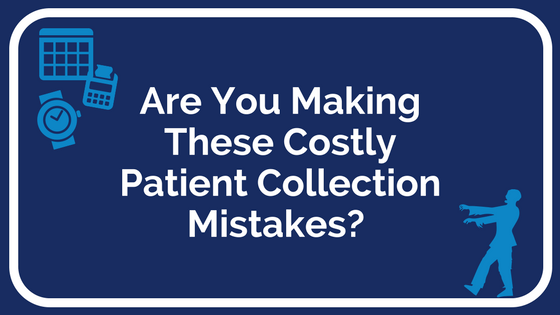medical collections

“The single biggest problem in communication is the illusion that it has taken place.”
– George Bernard Shaw
It’s no secret that good communication is the key to success in business, and in life. However, too often in the middle of a busy day at your practice, communication can break down. According to Pamela Ballou-Nelson, RN, MSHP, PhD, PCMH CCE for the MGMA, “For too long the focus has been on fixing patients yet there is a significant body of research that suggests that provider and staff behaviors (communication styles) are equally responsible for shortcomings in patient activation.”
Failing to communicate well with a patient will not only lead to a poor patient experience, but it can actually cost your practice money. When communication breaks down with a patient the result is low health literacy on their part, which means extra time and cost for your practice in dealing with unnecessary phone and in-person follow up.
The key to good communication with patients is to communicate in a way that resonates for them. Every person’s communication style is different, and is often linked to personality styles. According to Maslow’s Psychological Model for Human Behavior there are four primary personality and communication styles. Knowing how to identify them, and changing your communication style to match that of the patient, will improve your engagement. It can also result in a better experience and possibly even better health results for your patients.
Read on for a brief discussion of the different personality and communication styles and download our free Personality Assessment to learn your style today! (Plus get a handy reference guide to use at your practice).
Results-Oriented
The results-oriented communicator is easy to spot, and is often wrongly assessed as being rude or impatient. They can appear impatient or argumentative, speak quickly and forcefully, and often want to just get to the point. Match their pace and provide information quickly. Don’t take offense, just be firm and give them the answers they are seeking succinctly, outlining their options and asking for their decision. The patient will appreciate your respect of their time and that you were able to answer all of their questions with authority. Remember, the healthcare system is confusing for most patients and you are often the smartest person in the room. Be the expert they need and it will guarantee a satisfactory patient experience.
Socially-Oriented
On the complete opposite side of the spectrum from results-oriented communicators are the socially-oriented. This patient is warm and friendly and will want to chat about themselves (or anything else for that matter!) Return their enthusiasm and rapid pace, and be empathic and upbeat to make a connection. But be careful, this patient can cause delays in your practice, so while you should let them talk sometimes you need to direct the conversation.
Process-Oriented
Patients who seem uninterested or short with you are likely process-oriented. As communicators they are quiet and unemotional, are not fond of small talk, and they use facts and logic to make decisions. They may not ask many questions but they are still looking for information from you in order to make the best decisions about their health, so give plenty of information and logical evidence. Be reserved and wait for them to respond, they may appear to not be listening but they are likely just “processing.”
Relationship-Oriented
It has been our experience that the majority of people within the healthcare industry are relationship-oriented, so these patients are probably very easy for you to communicate with. They are cooperative, helpful and will wait for you to explain everything. Build rapport and match their warm and friendly tone and slower pace. Acknowledge their feelings and uncertainty and offer support, and be sure you don’t push.
Once you know what to look for, and make an effort to match the communication styles of your patients, you will be amazed at the outcome of your conversations! Maybe changing the way you connect will not guarantee that the patient will retain everything you say, but it will result in a positive experience for them and keep them coming back to your practice!
Learn your personality style, and how to recognize others. Download the personality assessment here, and the style descriptions here and start connecting better!
For more on how to create a better connection with your patients, watch our Patient Collections 101 webinar on demand! 
Take this article with you! Click here for a printable version.
Written by Ali Bechtel, Digital Marketing Manager for RMP
This information is not intended to be legal advice and may not be used as legal advice. Legal advice must be tailored to the specific circumstances of each case. Every effort has been made to assure this information is up-to-date as of the date of publication. It is not intended to be a full and exhaustive explanation of the law in any area, nor should it be used to replace the advice of your own legal counsel.

It’s a busy afternoon and the practice’s front desk is understaffed, again. After several minutes and a rush of registrations the last patient to walk in finally approaches the counter. Despite the rush of patients the front desk representative offers a friendly greeting, confirms the patient’s general demographic and insurance information, and confirms that she does not owe a co-pay. The rep also notices that the patient has a high outstanding balance and a $5,000 deductible that she has not met yet. The practice’s financial policy states that high deductible health plan patients with a high balance must establish a payment plan in order to receive care, but she is already running late for her time slot so the rep lets her know that following her appointment she will need to meet with a patient account representative to establish one.
Following her appointment the physician walks the patient out of the office, bypassing the check-out desk. On review of the patient’s file the representative finds a note from the physician that the patient was upset that she had to wait so long only to be confronted about her balance, so he instructed her to proceed without checking out and informed her that she would simply receive a statement for the day’s visit in the mail.
True or False: This practice has a collections culture
The patient access representative followed all the proper steps at registration and made an effort to enforce the practice’s financial policy, but the physician overruled and undermined her efforts. So the answer is false, this practice does not have a collections culture.
Typically the greatest challenge when working with patients with HDHPs is front office communication about financial responsibility, but following the proper collections protocol is not enough. There must be an organization-wide culture of collections within the practice that aims to maximize not only recovery, but also patient satisfaction. It may seem counterintuitive that asking a patient for money at the time of service is creating a good experience, but they will be more appreciative of the explanation of their responsibility before receiving services than they will of receiving an unexpected statement weeks later.
So how do you create a collections culture?
Culture Starts at the Top
A healthcare organization’s culture is its set of beliefs and behaviors that determine how employees and management interact to handle patient encounters. New employees don’t bring culture with them, it has to be created within the organization and it starts with leadership. There must be executive buy-in and a top-down decision to create a culture of collections within the practice. In the case of a physician practice, it is the responsibility of management as well as the physicians to understand the importance of patient collections, and to support the rest of the organization in meeting set goals. While a clear financial policy and employee training are valuabl
e, it is the entire organization’s commitment to upholding it that makes all the difference.
Create the Right Team
Leadership can determine what the healthcare organization’s culture should be, but it is key to hire people who will embrace it. Patient expectations are changing. They are seeking more financial transparency. Your patient access staff must have the expertise and experience to be able to answer their questions, or you risk a poor patient experience, and possibly losing that patient altogether. Practices can no longer afford to hire a friendly face for check-in. Front desk representatives must be trained for a much more complex job in deciphering eligibility and benefits, providing estimates, and acting as a financial counselor for HDHP patients.
For tips on how to build a ridiculously successful team, download our webinar on demand.
Provide the Right Tools
Having a collections culture requires giving your team the right tools for the job. Provide the technology and estimate tools they need to streamline their workload and give them access to the information patients are seeking. If your practice cannot commit to the latest technology, provide training opportunities and support that enable your staff to collect the information manually. Either way, if they cannot provide the patients with the information they seek, the patient will find another practice that can.
Teach Everyone in Your Organization to Say “I’m Sorry”
Collecting money from patients requires a positive mindset. Not only should everyone in your organization be able to empathize with patients, they need to be empowered and motivated ask for payment. Help change your employees’ mindset about collecting money with our free webinar on demand: Collecting from Patients – The Human Component. If you can build a team that is motivated and willing to uphold the culture established by the top-level, both recovery and patient satisfaction are sure to improve as a result.
Take this article with you! Click here for a printable version.
Written by Ali Bechtel, Digital Marketing Manager for RMP
This information is not intended to be legal advice and may not be used as legal advice. Legal advice must be tailored to the specific circumstances of each case. Every effort has been made to assure this information is up-to-date as of the date of publication. It is not intended to be a full and exhaustive explanation of the law in any area, nor should it be used to replace the advice of your own legal counsel.

Your receivables management partner should be monitoring and adapting to the ever-changing regulations in both the health care and debt collection industries on your behalf. However, there are a few reporting best practices you should follow to ensure that your agency, and your practice, can maintain compliance. In this article we will discuss the most important information you should be sharing with your medical collection agency or RCM partner on a regular basis.
Updated Patient Information
The Fair Credit Reporting Act (FCRA) and Fair Debt Collection Practices Act (FDCPA) have strict regulations in place for protecting patients from unfair collection practices. One of these regulations requires the timely reporting and updating of patient information, especially when a derogatory mark is being placed on their credit report.
The three major national credit bureaus – Experian, Equifax, and TransUnion – are now requiring at least a date of birth and/or a social security number as a unique identifier for every patient account being reported to ensure the wrong person is not being affected. It is critical that your agency has the most current demographic information for each of your patients. This is not only important if your practice credit reports, it will also ensure they are following up on the proper patient accounts and can help avoid HIPAA and Telephone Consumer Protection Act (TCPA) violations.
Payments
It is not uncommon for a patient who has been contacted by a debt collector about their bill to reach out to your practice or hospital to settle their balance. To ensure your agency is attempting to collect the right amount, they must have the most up to date balance on all accounts. This is particularly important if your agency credit reports. New credit scoring models and initiatives remove paid accounts from consumer credit reports, and if payments are not promptly posted and subsequently removed it could result in a dispute.
Even if your practice does not credit report, failure to report payments to your agency can still result in improper billing, which could certainly affect patient satisfaction and their relationship with your practice.
Credit Disputes
The FCRA also requires data furnishers to conduct an in-depth investigation of all credit report disputes within thirty (30) days. This review must include any supplemental information provided by the bureau as well as all information provided to your office by the patient since the date of service in question.
In order to comply with this mandate, it is essential to develop a policy for communication with your agency in the event of a dispute to ensure investigations are conducted thoroughly and in a timely manner. An open channel of communication and proper documentation sharing will also result in the timely removal of any inaccurate or incomplete data furnished to the bureaus.
For your agency to be able to assist in these investigations, your practice must provide all available information within the allotted time frames to ensure the investigation is completed properly.
Bankruptcy Notices
When a patient files for bankruptcy an automatic stay is immediately placed on all creditors. This stay bars all collection efforts against the patient until the case is resolved. Any collection activity by your practice or your agency can be considered a violation of the court order.
Your agency should scrub accounts for bankruptcies before beginning any collection efforts, but it is still important to provide them with any notices you receive. Doing so will ensure they are not improperly reaching out to a protected patient.
Past-Due Accounts
One of the most important reporting tips we want to share is not about compliance, but about recovery. The cost to collect a past-due balance only increases as accounts age. Best practices suggest that you should be sending accounts to your agency no later than 120 days after delinquency, so long as that is line with your practice’s financial policy. Regardless of the age you choose, your practice should decide when to send collection accounts to your agency, share that timeline with patients in your financial policy, and strictly adhere to it.
In addition to collecting more of your past-due balances, agencies will also typically charge a smaller fee on younger accounts. Consistent reporting to your collection agency will help to improve their recovery and lower your costs for a much healthier revenue cycle.
Establishing solid lines of communication and policies for reporting any activity on accounts that have been sent to bad debt can help to ensure that both you, and your agency on your behalf, are in compliance with these strict federal regulations. Proper reporting will also ensure the smoothest account handling and can help to maintain the relationship that you have built with your patient by avoiding errors and disputes.
For a free downloadable guide of these best practices, click the button below:![]()
Take this article with you! Click here for a printable version.
Written by Ali Bechtel, Digital Marketing Manager for RMP
This information is not intended to be legal advice and may not be used as legal advice. Legal advice must be tailored to the specific circumstances of each case. Every effort has been made to assure this information is up-to-date as of the date of publication. It is not intended to be a full and exhaustive explanation of the law in any area, nor should it be used to replace the advice of your own legal counsel.

Both healthcare providers and medical collection agencies alike hear a common complaint among patients who have been sent to bad debt: “I didn’t know I owed a bill.” More than likely your healthcare organization has a procedure in place to send several statements over a period of time, and best practice organizations will also follow up early and often by phone.
But must you also notify the patient prior to sending them to collections?
The Short Answer
Generally creditors are not required to notify debtors when they turn a delinquent account over to collections. The Truth in Lending Act does require written disclosure of credit terms, but this requirement should be met by your financial policy. If you intend to send past-due accounts to bad debt, you must indicate that, including the timeline, in your financial policy to be signed by all patients prior to rendering services.
The only exception is if your financial policy expressly states that you will provide notice, but most disclosures exclude notifications except as a courtesy.
How Are Patients Notified?
Your medical debt collection agency is required to notify patients that their account has been placed. Under Section 809 of the FDCPA, debt collectors must provide written notice containing (1) the amount of the debt; (2) the name of the creditor to whom the debt is owed – in this case your hospital or practice; and (3) provision of a 30 day period in which the patient can dispute the debt.
Courtesy Notifications: A Best Practice
Many consumers mistakenly believe that you are required to notify them before their account is sent to bad debt. While you now know that is not the case, it may be a best practice to provide notice as a courtesy on their final statement. If you are able to prepare a patient for the next steps, as outlined in the financial policy that they signed prior to receiving services, they are less likely to react so strongly when it does happen. Avoiding this “surprise” could help you maintain that patient relationship. Additionally, a courtesy notification may also result in payment prior to collections, which can save your organization agency fees and could also result in higher recovery on the balance.
Take this article with you! Click here for a printable version.
Written by Ali Bechtel, Digital Marketing Manager for RMP
This information is not intended to be legal advice and may not be used as legal advice. Legal advice must be tailored to the specific circumstances of each case. Every effort has been made to assure this information is up-to-date as of the date of publication. It is not intended to be a full and exhaustive explanation of the law in any area, nor should it be used to replace the advice of your own legal counsel.

When attempting to collect from patients it is easy to make simple mistakes that could cost your practice money. Financial conversations can be stressful, and in order to make it as comfortable for the patient as possible representatives may be too accommodating and make arrangements that do not benefit the practice in order to maintain the patient relationship.
However, there are ways to address the patient’s needs and secure acceptable payments for your practice. In this article and video series we share some of the most common patient collection mistakes you could be making, and simple tips for avoiding them.
The $10 Payment Trap
When establishing a payment arrangement it is very easy to fall into the $5 and $10 payment trap. When you ask a patient, “How much can you put toward this balance today?” you will inevitably hear $5, $10, maybe even nothing at all. When asked this question patients are often considering what they have available at that moment, after all of their other bills have been paid.
Instead, phrase the question this way: “How short of the balance are you today?” In our experience this question is often met with much higher commitments because it forces patients to consider their entire balance, rather than what they want to put toward it at that moment.
Long-Term Payment Arrangements
Once a patient has agreed to a monthly payment on their balance it is tempting to accept any amount they are willing to pay just to establish a consistent payment schedule. What representatives and patients alike do not consider when working out a payment amount is the length of the arrangement being established.
Consider this: accepting an arrangement of $10/month on a $500 balance is agreeing to give the patient more than 4 years to pay their bill. When you point this out to the patient even they will probably agree that it is an unreasonable arrangement. Keep a calculator by your desk in order to quickly calculate the length of an agreement before committing to it to ensure that you do not enter into a payment arrangement that is not beneficial for your practice.
Waiting Too Long to Begin Collection Calls
The chance of recovering your balance in full after the time of service decreases by 50% as soon as your patient walks out the door and the cost to collect only increases over time. According to the American Collector’s Association, the average recovery rate after 180 days – when most practices begin collection efforts – is only 13%.
One of the most common mistakes in patient collections is waiting too long to begin the process. This does not mean sending delinquency notices within a few days of service. There are simpler steps you can follow to help the patient prepare for their responsibility that can lead to higher recovery and a better patient experience. Provide an estimate prior to services being rendered whenever possible, and be sure to discuss responsibility before, during, and shortly after the time of service. Don’t miss the opportunity to collect more for your practice by waiting until after the patient’s appointment to begin a dialogue with them about their responsibility.
For tips and best practices for collection more at every stage of the revenue cycle, download our patient collections eBook!
Holding on to Past Due Accounts Too Long
The cost to collect from your patients does not only increase for your practice over time. The age of an account also affects the costs for your third-party medical collection agency. Most agencies will charge a higher fee on older accounts to compensate for the additional time and resources required to collect them. For optimum recovery we suggest sending your accounts no later than 120 days after delinquency.
Regardless of the age you choose, your practice should make a decision when to send delinquent accounts to your agency, share that timeline with patients in your financial policy, and strictly adhere to it. In addition to collecting more of your past-due balances, your patients will gain an understanding of your policies and procedures and may be timelier with future payments. Consistent reporting to your collection agency will also help to improve their recovery and lower your costs for a much healthier revenue cycle.
Want to keep this information handy? We made you a printable guide. Click here for your copy.
Take this article with you! Click here for a printable version.
Written by Ali Bechtel, Digital Marketing Manager for RMP
This information is not intended to be legal advice and may not be used as legal advice. Legal advice must be tailored to the specific circumstances of each case. Every effort has been made to assure this information is up-to-date as of the date of publication. It is not intended to be a full and exhaustive explanation of the law in any area, nor should it be used to replace the advice of your own legal counsel.

“Stop harassing me!”
Hopefully you have not had this conversation too many times in your attempt to collect a past-due balance from a patient, but chances are you or someone on your patient accounting team has heard this before.Continue Reading What is Harassment in Collections?

Whether to credit report your patients’ overdue medical debt is a business decision that must be made by healthcare leadership in every organization, from single-provider practices to health systems. It can be a difficult one to make when your organization is in the business of providing care.Continue Reading The Business of Providing Care | FAQs about Credit Reporting Medical Debt









